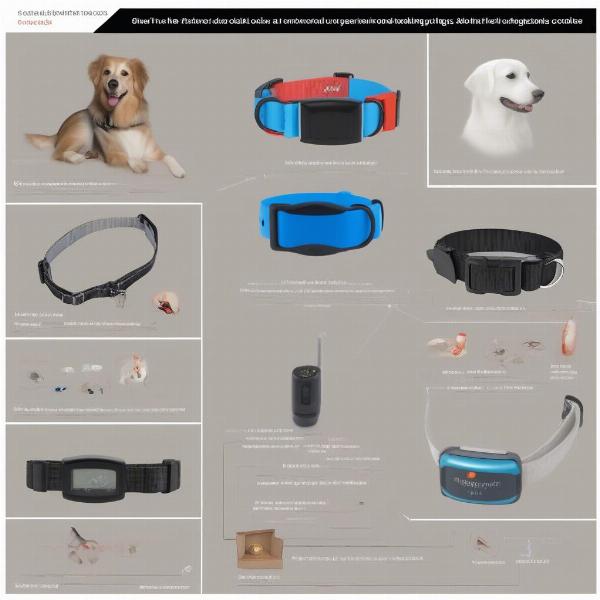Electric collars, also known as e-collars or shock collars, are a controversial tool in dog training. Understanding their purpose, proper usage, and potential risks is crucial for any dog owner considering this method. This article aims to provide a comprehensive guide to electric collars for dogs, covering everything from how they work to the ethical considerations surrounding their use.
While electric collars can be effective in certain training situations, they are not a one-size-fits-all solution and should never be used as a quick fix for behavioral problems. Misuse can lead to increased anxiety, fear, and aggression in dogs. Positive reinforcement methods are often preferred and should always be the first approach.
Types of Electric Collars and Their Functions
Electric collars come in various forms, each with its specific function:
- Training collars: These deliver a static correction to interrupt unwanted behaviors like excessive barking or pulling on the leash.
- Bark collars: Designed to automatically deter barking, they activate when the dog barks, emitting a sound, vibration, or static correction.
- Invisible fence collars: These create a virtual boundary, delivering a static correction when the dog approaches the perimeter.
- GPS tracking collars: While not strictly training collars, some GPS trackers have an integrated training component, allowing owners to deliver a tone or vibration remotely.
Each type uses different stimulation levels and triggers, so understanding the specific needs of your dog and the purpose of the collar is essential.  Different Types of Electric Dog Collars
Different Types of Electric Dog Collars
Are Electric Collars Safe for Dogs?
The safety of electric collars is a hotly debated topic. When used correctly and responsibly, they can be a valuable tool, but misuse can have negative consequences. The key is to use the lowest effective stimulation level and to prioritize positive reinforcement techniques. Never use an electric collar as a punishment or to inflict pain. electric collars for small dogs
Potential Risks of Electric Collars
- Physical harm: High stimulation levels can cause burns or tissue damage.
- Psychological distress: Improper use can lead to fear, anxiety, and aggression.
- Behavioral problems: Over-reliance on electric collars can mask underlying behavioral issues that require addressing through positive reinforcement training.
Minimizing the Risks
- Consult with a certified professional dog trainer before using an electric collar.
- Start with the lowest stimulation level and gradually increase only if necessary.
- Pair the collar with positive reinforcement methods.
- Never leave the collar on for extended periods.
- Monitor your dog for any signs of discomfort or distress.
Choosing the Right Electric Collar
Selecting the right electric collar requires careful consideration of your dog’s breed, size, temperament, and the specific behavior you’re trying to address. electric collar for big dogs Consulting with a professional trainer can help you make an informed decision. For smaller breeds, it’s important to choose a collar designed specifically for their size and weight.
Training Your Dog with an Electric Collar
Training with an electric collar requires patience, consistency, and a thorough understanding of how the device works. Always prioritize positive reinforcement and use the collar as a tool to interrupt unwanted behaviors, not to punish. best electric shock dog collar uk
- Start with basic obedience commands: Once your dog understands basic commands like “sit” and “stay,” you can introduce the electric collar.
- Use the lowest effective stimulation level: Start with the lowest setting and only increase if necessary.
- Pair the correction with a verbal cue: This helps your dog associate the correction with the unwanted behavior.
- Immediately reward desired behavior: When your dog responds correctly, praise and reward them.
Conclusion
Electric collars can be a useful training tool when used responsibly and in conjunction with positive reinforcement methods. However, it’s crucial to understand the potential risks and to prioritize your dog’s well-being. Always consult with a professional trainer before using an electric collar and carefully consider whether it is the right choice for your dog. electric for dogs
FAQ
- Are electric collars cruel? When misused, they can be. Proper usage, however, focuses on behavior modification, not punishment.
- Can I use an electric collar on a puppy? It’s generally not recommended for puppies younger than six months.
- What are the alternatives to electric collars? Positive reinforcement training methods, such as clicker training, are often preferred.
- How do I find a qualified dog trainer? Look for certified trainers with experience in positive reinforcement methods.
- Can electric collars cause aggression? Misuse can exacerbate aggression, highlighting the importance of proper training and usage.
- Are there different types of electric collars for different breeds? While not breed-specific, collars are available in various sizes and strengths to suit different dog sizes and temperaments.
- Can I use an electric collar for all behavioral problems? No, electric collars are not a solution for all behavioral problems and may be inappropriate for certain issues.
About ILM Dog
ILM Dog (ilmdog.com) is your global resource for expert dog care and training advice. We offer practical, reliable information on all aspects of dog ownership, from breed selection and puppy care to senior dog health and behavior training. Our goal is to empower dog owners with the knowledge they need to provide the best possible care for their canine companions. For expert guidance on dog training, nutrition, and products, contact us at [email protected] or +44 20-3965-8624.